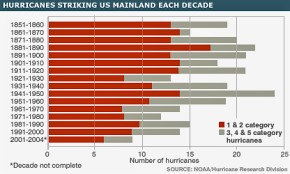Hurricane (Environmental & Earth Science)
Contents
Hurricane
A hurricane or typhoon is a tropical cyclone in which the maximum sustained surface wind (using the U.S. 1-minute average) is 64 kt (74 mph or 119 km/hr) or more. Tropical Cyclones originate over tropical or subtropical waters, with organized deep convection and a closed surface wind circulation about a well-defined center.The term hurricane is used for Northern Hemisphere tropical cyclones east of the International Dateline to the Greenwich Meridian. The term typhoon is used for Pacific tropical cyclones north of the Equator west of the International Dateline. Examination of historic and proxy records shows no correlation of hurricane frequency with Earth temperature change or carbon dioxide atmospheric concentrations, other than a slight decline in hurricane frequency in the modern era.
New World Recorded history
In North America records of hurricane frequency and intensity have been kept since about 1870. These records indicate wide variations in hurricane events from year to year; however, there is no evidence of increase in frequency or severity of the actual physical events. In fact, NOAA records indicate a gradual decline in hurricane frequency and intensity of hurricanes from 1850 to present. In particular there is no correlation between industrialization, greenhouse gases or fossil fuel combustion with hurricane frequency. Sometimes damage claims from insurance companies are used as a surrogate for the physical hurricane events; however, that provides great inaccuracy, because of increased numbers of people using property insurance and considerable inflation in real estate values in the last century.
Asian Typhoon Historical Frequency
On a decadal average, the twenty-year interval from 1660 to 1680 AD is the most intense typhoon period of record, with 28 to 37 typhoon landfalls per decade. The variability in typhoon landfalls in Guangdong parallels observations in other Asian paleoclimatic proxies (such as tree rings, ice cores). Notably, the two periods of highest typhoon landfalls in Guangdong (AD 1660-1680, 1850-1880) coincide with two of the coldest periods in China during the Little Ice Age. Thus, as in the case of hurricanes, there is no correlation of typhoon activity with industrialization, combustion of fossil fuels, global warming or greenhouse gases. In fact, highest typhoon frequency occurred in the coldest century of the last millennium.
Examination of sediment cores and other climate proxy data suggests there is no basis that hurricane frequency or intensity has changed throughout the Holocene period.
References
- K. R. Briffa, P. D. Jones, T. S. Bartholin, D. Eckstein, F. H. Schweingruber, W. Karlén, P. Zetterberg, M. Eronen, Fennoscandian summers from A.D. 500: Temperature changes on short and long timescales. Clim. Dyn. 7, 111–119 (1992).
- Kam-biu Liu, Caiming Shen and Kin-sheun Louie (2001) A 1,000-Year History of Typhoon Landfalls in Guangdong, Southern China, Reconstructed from Chinese Historical Documentary Records. Annals of the Association of American Geographers. Vol. 91, No. 3 (Sep., 2001), pp. 453-464 (12 pages). Published By: Taylor & Francis, Ltd.

